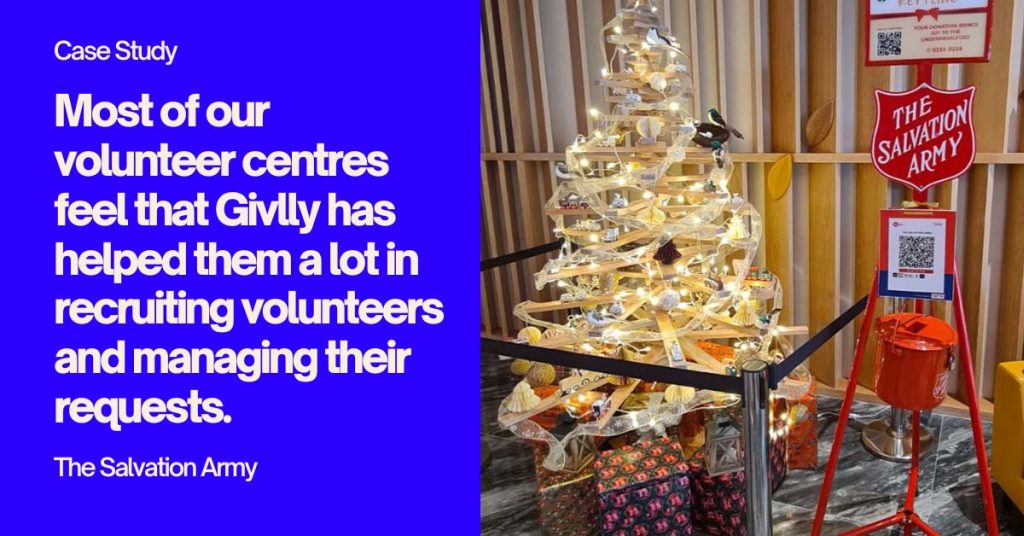With their red kettles and bells, the Salvation Army Christmas Kettling campaign with its ringers can be considered as much a part of Christmas as other activities such as carolling or Santa appearances. Started in 1891 in San Francisco by Salvation Army Captain Joseph McFee, the initiative has become an iconic part of the organisation’s many outreach drives and globally achieves hundreds of millions of dollars in donations for the underprivileged.
In Singapore, the programme has also been a key fixture around the island. Last year, the signature event took place at locations such as 18 Robinson, Bugis Junction, NEX, Suntec City, Tampines Mall, West Mall and more, in the hopes of raising funds for those in need. Donations go towards a broad string of efforts, including protection for vulnerable children and youth, help to struggling families, nursing care for frail elderly, and care for isolated migrant workers.
For a campaign so extensive, the Christmas Kettling campaign needed a boost in manpower for a very specific period – approximately one month. The team of bell-ringers rallied is often made possible by the kind contributions of volunteers and their time, and this required Salvation Army Singapore to attend to an annual exercise of recruitment, management and retainment of the volunteer pool.
In 2022, the organisation tapped into Givlly’s Volunteer Management System (VMS) to help ease this process. Some of the improvements it seeked included defined workflows, centralised data management, and more efficient processes to expedite the volunteer pool, their assignments and requests.
Givlly speaks to Ms Ignez Lum, the Public Relations Executive for Volunteer Management at Salvation Army Singapore, to find out how it went.
Why the team at Salvation Army Singapore decide to use a VMS for last year’s 2022 kettling campaign?
We decided to use a VMS to minimise the time spent on manual registration and have easier management of volunteer sign-up profiles. With the additional collaboration from church centres, we were anticipating 300 or more volunteers to sign up. And so, to smoothen the registration process, we use a VMS to encourage and simplify self sign-up, and deal with less back-end work.
How easy was it to implement this into your existing organisation’s processes?
With the help of Givlly’s team, it was not difficult to implement the functions we needed and there was no need to change existing features. In fact, thanks to the vendor support, our kettling sign-up volunteering site was as user-friendly to the public, as it was to the back-end user who was tracking and updating the profiles.
What was the one thing that made you take notice of the VMS?
The detailed fields enabled me to feature my opportunity with specificity. For instance, it allows me to fill in the skills required within those opportunity roles. Also, the systematic layout of these
requested details on the back-end eventually helps the front-end users – the volunteers – to easily and clearly see the necessary information and requirements.
What were some of the feedback received from your peers or volunteers?
Most of our volunteer centres feel that Givlly has helped them a lot in recruiting volunteers and managing their requests.
On how it works
Co-founder Mr Andy Choo elaborates on the features of the VMS, and explains that Givlly introduces optimisation to the process in a few ways. The first is through automation, which eliminates unnecessary data entry, generates relevant reports, and produces templates and reminders to help with volunteer management and retention.
Having a centralised system also helps with a single source of truth, allowing volunteer managers VMs) to quickly access the relevant information they need. These can include individual statistics, or general consolidated information such as the number of volunteers, their participation status, contribution hours, and even number of participated events.
Finally, a more democratised system allows for better communication and scheduling. Givlly allows volunteers to maintain their own profiles and select their preferred schedule, which allows VMs to easily and quickly assign interested parties. Also, instead of using mail-merge, VMs can generate participation certificates with just a click, using all the existing details and have it tagged to the document and ready for print. Once alerted in their emails, volunteers can immediately login to the app to access and print out their own certificates. VMs can also quickly filter and send targeted communication to relevant volunteers under the consolidated database.
For Salvation Army Singapore, the teams also worked closely with the organisation to implement customisation to fit their needs. Meanwhile, these feed back to the developments to drive new innovation within the app. Mr Choo adds, “After all, whenever we are introducing a new feature, we always look at how much time this function can save.”
Final thoughts
As a long-standing user of Givlly, the team asked Ms Lum about any positive takeaways from her experience with the app. The volunteer manager highlighted the efficiency and steady improvements of the platform as her top two benefits. She adds that she looks forward to new sets of features coming out from the evolving developments, and includes shareable links to further outreach as one of her wish list items.
“We’re glad that Givlly is always prompt in answering our queries and efficient in rectifying issues when they arise. The support they gave us exceeded our expectations. Also, they are always open to suggestions and keep improving Givlly which is important to users like us.”
If you’d like to learn more about how Givlly can help you better engage with your volunteers through our volunteer management solution, please don’t hesitate to get in touch.
